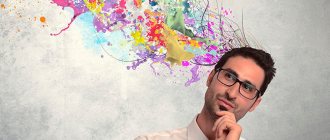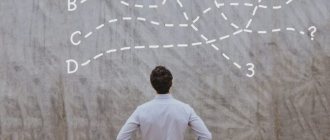There is a wide variety of problems that require different types of thinking to solve. In psychology, it is customary to divide thinking into discursive and intuitive. Discursive thinking is a thought process during which a person sequentially goes through different types of solutions to a problem. Let's take a closer look at this type of thinking and find out how it works.
What is discursive thinking?
The concept of “discursive” comes from the Latin “discursus”, which translates as “reasoning”. That is, in the process of such thinking, a person finds the answer to a question that interests him as a result of dialogue with himself. He selects the necessary key to the solution in the same way as a child acts when putting together a jigsaw puzzle. By alternately “substituting” first one or the other of his assumptions, based on logical conclusions, a person makes his own conclusion. And both deduction and induction can be used:
- deduction involves a transition from general concepts to a particular case;
- induction involves moving from a particular judgment to a general conclusion.
For example, it’s easy to guess that if a child’s school is quarantined, most of his colleagues are sneezing at work, and there are queues at pharmacies, then a flu or ARVI epidemic has come to the city. However, such conclusions are not always so clear-cut. Statements like “all men are goats”, “all women are fools”, “all children are capricious”, “all salesmen are thieves” and so on are also made on the principles of induction.
To avoid them, you need to act according to the following instructions.
- Collect information with a “cool” head. Don't attach your own feelings and prejudices to it.
- Analyze the information received. Perhaps it will be possible to derive some patterns. Make a comparison - find similarities and differences.
- Now you can draw a conclusion about the event, phenomenon or person you are interested in.
- Check the received data. To make a final verdict, find evidence to support your conclusions. To do this, once again examine the facts and circumstances or simply observe what is happening.
Such techniques help not only to correctly assess the situation, but also to influence it. Discursive thinking can be useful both in everyday matters and in business.
Let's consider several situations. Your son doesn’t want to clean up his room. You have already told him more than once that he is unclean and demanded that he clean his six square meters. However, the cart with its socks, CDs, books, notebooks, pants and T-shirts is still there.
Let’s try to approach it from the other side: “Dear child, look how pleasant it is to be in your sisters’ room. Everything is sorted out there, they quickly find their things and don’t stumble over various obstacles, isn’t it time for you to create some comfort?” Most likely, such a proposal will be much more successful than a comparison with a pig and orders given in the form of an ultimatum.
Your daughter cried all day when you canceled your trip to the zoo because of the rain. Remember what you told her. Most likely, it sounded something like this: “We’re not going to the menagerie - it’s damp outside.” If the next time the “heavenly office” gets in your way again, the following wording is recommended: “Today strong winds and rain are expected, it’s terribly uncomfortable to walk in such conditions, let’s reschedule the walk until next weekend.” You'll see, your daughter will thank you for taking such good care of her.
There is no way you can sell a batch of soap that was developed by the best specialists of your company. What do sellers tell buyers? “This is our most successful product. It contains only natural ingredients. It gives a wonderful aroma to the body and freshness to the skin.”
“Flip” the presentation. This soap will make your skin smooth, give an unforgettable aroma, will not cause allergic reactions, as it is made from natural ingredients, and, by the way, this is one of our most successful finds. Is there already a line at the counter?
To do this, memory, observation, ability to concentrate and analytical data must be well developed. In psychology, this type of thinking is called slow, while another type is considered fast - intuitive.
Types of thinking
According to the degree of deployment they are distinguished:
Discursive thinking is analytical thinking based on the logic of reasoning.
Intuitive thinking is based on direct sensory perceptions and direct reflection of the influences of objects and phenomena of the surrounding world.
By nature they distinguish:
Theoretical thinking is thinking based on theoretical reasoning and conclusions, this is the knowledge of laws and rules.
Practical thinking is reasoning when solving practical problems, its goal is to develop means of practical transformation of reality: setting a goal, creating a plan, project, scheme.
Theoretical thinking, in turn, is divided into conceptual and figurative.
Conceptual thinking is thinking that uses certain concepts. Conceptual thinking provides the most accurate and generalized reflection of reality, but this reflection is abstract.
Figurative thinking is a type of thought process that uses images . These images are extracted directly from memory or recreated by imagination. Imaginative thinking allows us to obtain a specific subjective reflection of the reality around us.
Based on their form, such types of thinking are distinguished as visual-effective, visual-figurative and abstract-logical (verbal-logical); these types of thinking can also be considered as levels of its development.
Visual-effective (pre-conceptual) thinking is a special type of thinking, the essence of which is that the solution to a problem is carried out with the help of practical transformative activities carried out with real objects. This form of thinking is dominant in early childhood.
Visual-figurative thinking is a type of thinking in which the solution to a problem is carried out using operations with images that arise in the immediate situation. The necessary images are represented in short-term and operative memory. This form of thinking is dominant in children of preschool and primary school age.
Verbal-logical thinking is a type of thinking in which the solution of a problem is carried out using operations with concepts. It is dominant starting from adolescence.
Abstract-logical is a more complex type of thinking, based on identifying the essential properties and connections of an object and abstracting from the unimportant.
Each of these types of thinking develops independently. Theoretical thinking is considered more perfect than practical thinking, and conceptual thinking represents a higher level of development than figurative thinking.
According to the degree of novelty and originality, they are distinguished:
Reproductive thinking is based on the assimilation and operation of ready-made concepts, judgments, patterns and their application in a certain situation.
Productive thinking is thinking that creates something new for the subject. The thinking process consists of finding a means to solve a problem, taking into account existing conditions. It lies at the heart of creativity.
The functions are distinguished:
Critical thinking – aims to identify deficiencies in judgment.
Creative – associated with the discovery of fundamentally new knowledge.
Basic forms of thinking
1. A concept is a reflection of the general and essential properties of objects or phenomena. Types of concepts:
q General concepts - cover a whole class of homogeneous objects or phenomena that bear the same name. For example, the concepts of “chair”, “building”, “disease”, “person”, etc. General concepts reflect the characteristics characteristic of all objects that are united by the corresponding concept.
q Single concepts – denote any one subject. For example, “Yenisei”, “Venus”, “Saratov”, etc. Single concepts represent a body of knowledge about any one subject, but at the same time they reflect properties that can be covered by another, more general concept. For example, the concept of “Yenisei” includes the fact that it is a river that flows through the territory of Russia.
2. Judgment is a form of thinking in the process of which connections between objects of reality are affirmed or denied. For example, “This table is brown”, “Metals expand when heated” - expresses the connection between changes in temperature and the volume of metals.
Judgments can be true (objectively true) and false (not corresponding to objective reality); general (when something is stated regarding all subjects in a group, for example: “All students take exams during the session”), specific (for example: “Some students are excellent students”) and individual (for example, “This student did not prepare well for the seminar.” )
Judgment is based on the subject’s understanding of the variety of connections between a particular object or phenomenon and other objects or phenomena. Understanding is the ability to comprehend the meaning and meaning of something. The concepts of “judgment” and “understanding” are not completely identical, but they are closely related to each other. If understanding is an ability, then judgment is the result of this ability.
3. Inference is the highest form of thinking and represents the derivation of a new judgment from one or more judgments. The initial judgments from which the conclusion is drawn are called premises.
Conclusions can be:
q Inductive - reasoning proceeds from individual factors to a general conclusion.
q Deductive - reasoning proceeds from general factors to specific conclusions.
q By analogy - a conclusion is made on the basis of partial similarities between phenomena. For example: it is light during the day and dark at night.
Inference as a form of thinking is based on concepts and judgments and is most often used in the processes of theoretical thinking.
The word “ intelligence ” comes from the Latin intellectus, translated into Russian meaning “understanding”, “understanding”, “comprehension”. Today there are two main interpretations of intelligence: a broader one and a narrower one. In a broader sense, intelligence is a global integral biopsychic feature of a person that characterizes his ability to adapt. Another interpretation of intelligence, a narrower one, combines in this concept a generalized characteristic of a person’s mental abilities.
Main types of mental operations
The main types of mental operations include: comparison, analysis and synthesis, abstraction and concretization, induction and deduction.
Analysis is the mental dissection of something into parts or the mental isolation of individual properties of an object.
The essence of this operation is that, perceiving any object or phenomenon, we can mentally isolate one part of it from another, and then select the next part, etc. In this way we can find out what parts it consists of. what we perceive. Consequently, analysis allows us to decompose the whole into parts, that is, it allows us to understand the structure of what we perceive.
Synthesis is a mental combination of parts of objects or phenomena into one whole, as well as a mental combination of their individual properties.
Being essentially opposite operations, analysis and synthesis are actually closely related to each other. They are involved in every complex thought process. For example, when you, knowing English poorly, hear a conversation in this language, you try first of all to identify familiar words in the spoken phrase, and only then perceive less familiar words and then try to comprehend them. This is where the functions of analysis come into play. However, at the same time, you are trying to put together the meaning of the words you heard and compose a meaningful phrase. In this case, you use another mental operation - synthesis.
Abstraction is a mental abstraction from any parts or properties of an object to highlight its essential features. Abstraction is widely used by us in the formation and assimilation of new concepts, since concepts reflect only essential features common to a whole class of objects. For example, when we say “table,” we represent a certain image of a whole class of objects. This concept unites our ideas about different tables. In order to form this concept, we had to abstract from a number of private properties and characteristics that are characteristic only of a certain object or a separate group of objects that are defined by the concept we formed.
Generalization is the combination of similar objects based on common characteristics. Any concept that people use is a generalization.
Concretization is a process opposite to abstraction; it is the representation of something individual that corresponds to a particular concept or general position. Essentially, specification always acts as an example or as an illustration of something general.
Comparison is the operation of establishing similarities and differences between objects and phenomena of the real world. Recognition of similarity or difference between objects depends on what properties of the objects being compared are essential for us. The success of the comparison depends on how well the indicators for comparison are chosen.
Classification is a derivative of comparison; it is a more complex operation of establishing the similarities and differences between the main and secondary characteristics of objects and phenomena. Thanks to this, it is further possible, based on the similarity of the main characteristics, to unite objects into related groups: species, genera, classes, etc.
Induction is an inference that represents a transition from particular cases to a general position.
Deduction is an inference that represents a transition from the general to the specific.
Solving complex mental problems and creative thinking
The thinking process begins with a problem situation that needs to be solved, and, consequently, with the formulation of a question that arises every time we do not understand something.
To solve a complex mental problem, you need to skillfully choose ways to solve the question posed. In some cases, we have no difficulty in solving a particular mental problem or practical problem. But it often happens that we do not have the necessary knowledge or information to answer the question posed. Therefore, to solve a complex mental problem, a person must be able to find the necessary information, without which it is impossible to solve the main task or problem. In this case, a person, using the capabilities of his thinking, first answers intermediate questions and only then solves the main question. Gradually supplementing the missing information, we come to a solution to the main problem or question that interests us.
When we do not have the information necessary to solve a problem, we usually make an assumption. An assumption is a conclusion that is based on indirect information and our guesses, when we do not have all the knowledge or sufficient information necessary to correctly solve a mental problem.
Practice is the most objective evidence of the truth of conclusions. A significant role in solving complex intellectual problems is played by the skillful use of various techniques. Thus, when solving problems, we often use visual images. Another example is the use of typical techniques in solving typical problems.
In a detailed thought process, several stages or phases can be distinguished:
1. Awareness of the problem situation.
2. Distinguishing what is known and what is not known. As a result, the problem turns into a task.
3. Limitation of the search area.
4. Constructing a hypothesis as an assumption about ways to solve problems.
5. Implementation of the hypothesis.
6. Hypothesis testing. If the test confirms the hypothesis, the solution is implemented.
However, there are times when a person with highly developed thinking tries to solve problems that are not similar to any known ones and do not have a ready-made solution. To solve such problems, we must turn to the possibilities of our creative thinking.
One of the first to attempt to answer the question of what creative thinking is was J. Guilford . In works devoted to creativity (creative thinking), he outlined his concept, according to which the level of development of creativity is determined by the dominance of four features in thinking. Firstly, it is the originality and unusualness of the ideas expressed, the desire for intellectual novelty. A person capable of creativity almost always and everywhere strives to find his own solution.
Secondly, a creative person is distinguished by semantic flexibility , i.e. the ability to see an object from a new angle, the ability to discover the possibility of a new use of a given object.
Thirdly, in creative thinking there is always such a feature as figurative adaptive flexibility , i.e. the ability to change the perception of an object in such a way as to see its new, hidden sides.
Fourthly, a person with creative thinking differs from other people in the ability to produce a variety of ideas in an uncertain situation , in particular in one that does not contain the prerequisites for the formation of new ideas. This ability of creative thinking was called semantic spontaneous flexibility by J. Guilford.
Subsequently, other attempts were made to identify the nature of creativity. These studies identified conditions that promote creative thinking. For example, when faced with a new task, a person strives first of all to use the method or method that was most successful in previous experience. Another equally significant conclusion that was made in the course of research on creative thinking is the conclusion that the more effort was spent on finding a new way to solve a problem, the higher the likelihood that this method will be used to solve another, new mental problem . At the same time, this pattern can lead to the emergence of a thinking stereotype that prevents a person from using new, more appropriate ways to solve a problem. Therefore, in order to overcome stereotypical thinking, a person must completely abandon attempts to solve the problem, and then after a while return to it, but with the firm intention of solving it in a new way.
During the study of creative thinking, another interesting pattern was revealed. Frequent failures in solving mental problems lead to the fact that a person begins to be afraid of meeting each new task, and when faced with a problem, his intellectual abilities are unable to manifest themselves, as they are under the yoke of a person’s lack of faith in his own abilities. For people to demonstrate their intellectual abilities, they need a sense of success and a sense of correctness in completing a particular task.
A number of studies have found that effectiveness in solving mental problems is achieved with appropriate motivation and a certain level of emotional arousal. Moreover, this level is purely individual for each person.
Modern thinking concepts
At the present stage, human thinking is the object of research in many sciences: psychology, sociology, logic, theory of artificial intelligence, etc.
- The psychological concept of thinking is built on the principles of the unity of activity and thinking, sociohistorical and cultural determination, development, systematicity, reflection. Modern psychology distinguishes intellectual (other) and intellectual operations (analysis, synthesis, comparison, generalization, etc.) in thinking.
- Sociological and socio-psychological concept of thinking.
- Logical-philosophical concept of thinking.
- Information-cybernetic concept of thinking.
- Heuristic concept of thinking.
How does intuitive thinking work?
Some people have developed intuitive thinking. They are able to solve problems without thinking about them, without conducting a logical and critical analysis of the situation. The answer to the task comes to them from within, from the subconscious.
Intuitive thinking involves subconscious processes. It works automatically in situations familiar to humans. For example, while driving a car, a person performs all operations unconsciously: he does not think about which way to turn the steering wheel, how to change gear or when to press the brake pedal. All this happens automatically because the person already has driving experience.
It also happens in any activity in which a person is well versed and has experience. The worker at the machine also does not think about his every action, he performs them automatically. An experienced doctor can diagnose a common disease without any tests, just by looking at the patient.
To achieve this level in any profession, psychologists recommend a conscious approach to mastering a new type of activity. It is necessary to take each step slowly, thinking and remembering all the details, working through each action many times. Gradually, the skills will move to the subconscious level, and in the future the person will be able to perform them automatically.
Prelogical thinking
This concept was introduced by L. Lévy-Bruhl. The term turned out to be necessary to designate the early stage of the formation of the basic laws of logic. We are talking about that stage of formation when the meaning of cause-and-effect relationships is already clear and realized, but its essence is not entirely clear and is even mystified. The reason for the appearance of certain conditions is necessarily some higher power, natural or animal (an example of this is the use of a totem, worship of the forces of nature, etc.). We are talking about that stage of human development when a severe thunderstorm or drought could be perceived as the wrath of the gods.
We should probably end here. Of course, there are many other types. But the ones we mentioned can be called the most basic. Now you know that in addition to the logical, there is also an intuitive type of thinking, and in addition to the practical, there is a pre-logical one. But keep in mind, it is not always possible to say that a particular person uses only one specific type. Most often, in different situations, people resort to different thought processes, often without controlling their choices.
Basic functions of thinking
- Cognitive (reflection of the world and self-reflection)
- Design (construction of plans, projects, models of practical and theoretical-cognitive activities)
- Forecasting (forecasting or anticipating the consequences of one’s actions, one’s activities, predicting the future)
- Informational (assimilation of information about knowledge and its semantic processing)
- Technological (development of rules, norms, standards, recipes for the lifestyle of man and society in various forms and manifestations)
- Reflective (self-knowledge of the mind, introspection)
- Interpretation (interpretation, understanding of the products of human culture)
- Analytical and synthetic
- Setting and solving various tasks and problems
Definition
The difficulty in formulating this concept lies in the fact that almost every adult has an idea of what exactly is called thinking. This is a way or means of obtaining information about the world around us and the processes occurring in it. It is indirect and generalizing in nature.
There are different types (types) of this process. These include: discursive, imaginative, intuitive, rational, practical and pre-logical thinking. Each of them is radically different in some ways, and in some ways, on the contrary, may be similar to any others. Let's find out what their differences and similarities are. In addition to types, the thought process has two forms: inference and judgment.
Inference is the result of all judgments, the final conclusion obtained from the information provided. There are only three types:
- deductive;
- inductive;
- Similarly.
It is worth considering each of them in more detail so that the subsequent information will be more understandable to you. Deductive is done on the basis of general rules in relation to any particular case. Reliable facts are taken as a basis, and on their basis a person comes to some conclusion. Let's give the simplest example. Metals are ductile, iron is a metal. This means it is plastic. With the inductive method, the individual, on the contrary, proceeds to a general judgment based on a particular case. An inference by analogy is one that is arrived at based on the similarity of two (or several) cases, objects or any properties.
A judgment is a separate thought about an object. By connecting them into a single chain, you can come to a certain conclusion. For example: “A person who committed a crime must be punished” is a judgment.
Deductive principle
Subject to the opposite pattern: the conclusion is drawn from the general to the specific. Usually people do not notice how they come to a certain decision, they cannot track the progress of their thoughts. That is, based on some general belief, you can come to a personal conclusion. Often people use the deductive method without even realizing it or thinking about what is happening. An example is the following situation: having become acquainted with the main work of a famous author, a person decides to read his early book, which few people know about, sincerely believing that it will also be incredibly exciting. Often people generally tend to do something out of emotion, under the influence of strong impressions.
The concept of “thinking” in the history of philosophy
The concept of thinking is in close connection with It is fundamental in the conceptual knowledge systems of philosophers of the past and present. The concept of thinking (gr. ???? - mind) and related concepts were formed by ancient philosophers and others).
According to Aristotle, thinking is part of the soul, another part of it is sensation. As a part of the soul, thinking is a specific ability to reason, to comprehend the world and oneself through opinion, that is, the soul. Thinking is an activity aimed at cognition and comprehension of the types of things. Exploring thinking, Aristotle created logic - the science of thinking, formulated laws and forms of thinking.
In the conceptual systems of modern philosophers (John Locke, Francis Bacon, Claude Adrian Helvetius, David Hume), thinking is an activity aimed at knowledge and practical action; it develops a method, i.e. a means, a method of cognition and practical action. Philosophers distinguish manifestations of thinking - sensation, contemplation, imagination, reflection; level of thinking - reason, mind; manifestations of thinking activity - doubt, faith, design, decision-making, understanding, imaginary transactions.
In the conceptual systems of representatives of classical German philosophy (Kant, Johann Gottlieb Fichte, Friedrich Wilhelm Schelling, Georg Hegel), thinking is considered as an act of self-activity of the subject, which gives rise to various intellectual, imaginary phenomena - concepts, principles, laws, ideas, ideals, i.e. knowledge.
Emmanuel Kant noted the spontaneity of acts of thinking, the a priori nature of its activity, the focus on knowledge through concepts, and identified levels of thinking - intuition, reason, reason; types and types of thinking - formal-logical (rational) and dialectical (reasonable), concrete and abstract, practical and theoretical. E. Kant defined the one-sidedness, limitations of reason and the antinomy of reason, and established connections between “pure” thinking and sensuality, with the outside world.
Hegel defines thinking as the activity of a subject aimed at understanding the world in the form of concepts (categories). The highest form of knowledge is science (philosophy), which cognizes the Absolute Spirit. Thinking is knowledge in the concepts (categories) of the Absolute Spirit, thanks to which universal knowledge is formed.
How to develop discursive thinking
You need to learn to consider several ways to solve a problem at once. Using logic, as well as life experience, you will eventually find the most suitable option for you.
Inductive method
Here are 2 examples of inductive inferences:
- Imagine that you are going to work on the bus. Many people sneeze, cough, and have a runny nose. And there have been a lot of customers in pharmacies lately. What will you think of first? It is logical to conclude that an ARVI epidemic has begun.
- You are still on the same bus. Unexpectedly, as you were leaving, the driver was rude to you. And this is not the first time in your life. Friends also spoke of similar incidents. You have found dozens of such situations on social networks and on TV. What is the conclusion? That minibus drivers are mostly boors and rude people.
In the first example, a completely logical conclusion was made. And in the second it was wrong. How to avoid errors in your judgment? There are a number of ways:
- Observe an object or phenomenon. Be dispassionate, unbiased. Study the facts, ignore assumptions.
- Analyze the information received. If possible, highlight the pattern, similarities or differences.
- Draw a conclusion based on your thoughts.
- Observe the object or phenomenon for some more time. This will help you confirm your conclusions.
Interestingly, with the help of inductive thinking you can convince people around you that you are right. It is enough to master 4 techniques:
- Extrapolation. This is the transfer of rules from one sphere to another. Used to encourage a person to do something he doesn't want to do. For example, you shouldn’t call a child a pig and a slob if he doesn’t clean his room. Try something different. Tell him that his friends are very responsible people who love order. And it’s time for him to join them.
- Argumentation with explanation of conclusions. Give arguments first, and then conclusions. Imagine that you are going on a picnic. Suddenly the weather turned bad. If you talk about canceling the trip and only then about the reason, the interlocutor will begin to argue and resist. It’s better to say this: “The weather forecast calls for rain. Therefore, it is better to cancel the picnic or postpone it to another day.”
- Argumentation describing the merits of individual elements and the conclusion or solution as a whole.
- Statement of facts, arguments, explanations. They must go in exactly this order. If you change the order, the speech will not be convincing.
Deductive method
How to develop discursive thinking using deduction? Learn to draw your own conclusions based on verified and confirmed facts. For example, it started to rain outside. You understand that the laundry drying there will become wet again if you don’t bring it home. The basis of the deductive method is reasoning.
Deductive method
The process of deductive thinking moves in the reverse order: based on general verified facts, a person makes specific conclusions. For example: you looked out the window and saw that it started to rain. It immediately becomes clear to you that the laundry hanging on the line will get wet if it is not removed. Another example: your dog comes home from a walk, happily licking his lips, and his nose and paws are smeared with dirt. You understand that she was digging in the ground and found something tasty.
The deductive method is based on logical conclusions. Reliable general facts allow us to draw accurate specific conclusions.
If you want to develop your thinking, learn to master both methods - inductive and deductive. Learn to notice the details of each phenomenon, as well as pay attention to the phenomenon as a whole. This will help you solve the problems you face more effectively.
Inductive method
An inference based on the principle of induction could be as follows: over the past few days, on the street, in transport, at work, you see people coughing, sneezing and blowing their noses, and there are queues at pharmacies. From this you conclude that an epidemic of influenza or ARVI has begun in the city. This is a very simple and logical conclusion.
However, the inductive method does not always allow one to come to the right conclusions. For example, today a minibus driver was rude to you. You remembered that you had similar incidents before. Then several of your friends said that they also often encountered rude drivers. In addition, you also heard on TV that the minibus driver was rude to a passenger. From here you can make the erroneous conclusion that all minibus drivers are complete rude people.
How to avoid mistakes in inductive thinking? You can use a special technique that allows you to develop this type of thinking, making it more productive. The method involves several sequential steps:
- Observation. Dispassionately and impartially observe the object or phenomenon that interests you. When collecting information, rely solely on facts, not assumptions.
- Analysis. Once you have collected all the necessary information, analyze it carefully. Identify existing patterns, find similarities and differences.
- Generalization. Summarize the analyzed information and draw a conclusion based on it.
- Confirmation. Continue to observe the object or phenomenon to find confirmation of your conclusions and conclusions.
If you want to learn how to convince people that you are right, master inductive thinking techniques that will help you make the right arguments in a conversation.
- Extrapolation is the transfer of a rule from one area of knowledge to another. The technique can be used to convince a person to do something. For example, you tell your child: “Clean up your room, don’t be a pig.” This is an unconvincing argument. You need to say this: “Your friends are very disciplined and keep their rooms in order. It’s time for you to join them and start maintaining order.”
- Argumentation followed by explanation of the conclusions. Usually people first voice their conclusions to their interlocutor, and then give reasons for them. For example: “We won’t go on a picnic because it’s going to rain.” Such wording may cause protest from the interlocutor. It would be more correct to say this: “Today’s weather forecast promises rain in the place where we are going to go. It’s best to cancel the trip and reschedule the picnic for another day.”
- Argumentation describing first the advantages of particulars and then moving on to the advantages of the whole. This technique can be used in marketing. Marketing experts argue that if you convince the buyer of the private benefits of a product, then it is easier for him to agree to purchase it. Incorrect wording: “This shampoo is produced using innovative technologies. It nourishes and moisturizes hair, strengthens it and accelerates growth.” Correct wording: “This shampoo nourishes and moisturizes hair, strengthens it and accelerates growth. It was produced using innovative technologies."
- Statement of facts and arguments first, and then explanations. If you first give your interlocutor an explanation and then argue for it, it will not seem so convincing. For example, you say: “Vasya, our neighbor’s boyfriend, stole flowers from the flowerbed.” But you need to say this: “I saw Vasya standing in front of our neighbor’s door with a bouquet of flowers. Dahlias are very similar to those that grow in the flowerbed in front of the house. I went outside, but there were no flowers, and the cut was recent. In addition, male footprints were imprinted on the ground. It was probably Vasya who cut the dahlias.”
Correct Interpretation
In fact, it is not enough to see the situation from the inside yourself. You also need to be able to interpret this correctly and give an objective assessment of what is happening. Based on logical thinking, a person can come to quite bold and ambiguous conclusions that under other circumstances simply would not come to mind.
Without such a skill, it is impossible to defend one’s position and develop in the chosen direction. An individual must constantly strive to double-check his guesses and make sure that he is right.
Thus, the types of discursive thinking listed above are necessary in order to competently structure the communication process. It is necessary to understand that the main thing here is to be able to listen correctly to your interlocutor, adequately perceive the emerging situation and draw certain conclusions. Then a person will be able to be in harmony with himself and with society. In any relationship you must invest creative energy, analyze what is happening around you and know exactly what certain actions can lead to.
Is it possible to improve intuition?
Many of us find it difficult to listen to our intuition. We are all blinded by rationality, so we find it difficult to believe in anything that does not use logic or some other scientific system. We push away many things that don't seem easy to explain. This is why we find it so difficult to use our intuition.
In addition, lack of self-confidence also blocks the ability to think intuitively. If you have many doubts about your subjective experience, all your intuitions will be contaminated by this doubt. So instead of helping you find the right answer (i.e. intuition), you become confused and skeptical.
The best way to improve your intuition is to allow it to flow more freely. One good strategy is to take note of the first thing that comes to mind in any situation. Make sure you write it down before your reasoning processes take over and let it come exactly as you see it, like automatic writing.
You can then review your notes and check if your initial impression was correct. If it makes sense and helps you solve or understand a situation correctly, then it is intuition. Doesn't this sound like a fun exercise? Why not try it?
Analysis
Any logical thinking implies that it will be necessary to discover existing patterns between individual objects or phenomena. The ability to analyze is very important and valuable in our everyday life. In order not to be mistaken with the final conclusion, there is no need to rush to come to a certain conclusion as soon as possible.
It is better to gradually take a closer look at the situation, trying to discover connections between individual objects. As a rule, nothing exists separately, by itself. If we try, we can always find something that unites completely different, at first glance, phenomena.
Intuitive Thinking
Modern psychology considers intuitive acts as part of discursive or other thinking in the process of solving creative problems, considering them as one of the stages of creative thinking (then there may be a link to a future article on creative thinking). As Herbert Simon, one of the founders of cognitive psychology, said, “Intuition is nothing more than recognition.” The development of intuitive thinking is possible if we consider intuition to be concentrated unconscious reasoning, and not an irrational process, if we assume that it is a consequence of concentrated experience.
How to help develop intuitive thinking?
• Become an expert in a particular field: In this case, instantaneous predictions will be based on experience and give realistic results.
• Develop imaginative thinking: this helps well predict people's behavior in a given situation.
• Learn to put yourself in someone else’s shoes in order to feel “in someone else’s shoes.”
• Learn to relax, relieve physical tension, stiffness, in other words – learn to be liberated.
• Learn in your imagination to feel yourself in the body of another person.
• Know non-verbal body language and be able to use it.
• Be able to adapt to the person, changing your behavior to suit the interlocutor in order to create trust, for better contact.
We wish you success in self-development!
Photo: Ana Bernardo
Development methods
If you set specific goals for yourself every day, you can definitely achieve their implementation. Discursive thinking must be developed. Even if you are a supporter of individual intuitive search, this is not a reason to give up logical skills. Then you will learn to understand other people and yourself without much stress. Any difficult situations require a responsible approach and a disciplined attitude. The development of discursive thinking is impossible without some self-restraints. You need to feel the situation well, know what is best to do at a certain time. Let's take a closer look at effective development methods.
Intuitive Thinking and Science
The topic of intuitive thinking has always led to all kinds of speculation. But since it's so tied to our emotions, it's not very easy to test anything about it.
But science has taken on this problem. One of the main programs that studies it is the Laboratory of Brain Evolution and Behavior (part of the National Institute of Mental Health in the USA), and its current director is Paul McLean.
According to their research, intuitive thinking originates from the neocortex. This is a special part of the brain that contains elements of both hemispheres. While they're not sure exactly how it works, they think it has something to do with instantaneous processing of knowledge, experiences, and signs around you. The end result of this processing is a correct interpretation of reality.
Definition of Intuitive Thinking
This type of thinking is mostly based on intuition. Connections are born almost instantly. A person, without hesitation, answers the question, relying mainly on his feelings. Intuitive thinking is considered a type of creative thinking. Sometimes it seems that this process occurs without the participation of logic, however, this is not the case. A person also builds certain analytical chains in his head, but this happens at lightning speed. Since in this case he is driven by something conceptual and intuitive. But this is also a certain form of rational thinking.
The solution seems to appear from above. Some call it a gift from God, others believe that such an ability can be developed. One thing is indisputable - a person who has the ability to think intuitively must have extensive life experience and have a solid store of knowledge in completely different areas. Therefore, even if this “gift” does not exist, it can be developed.
Basic principles
You need to know them in order to understand how this form of cognition works. If a person does not think about it, he will not be able to come to a satisfactory result. The principles of discursive thinking are aimed at developing an understanding of how people make decisions and what they base their conclusions on. This is very important for a harmonious perception of reality. Sometimes in life you have to solve many problems at the same time and pay attention to sudden changes.
Intuitive Thinking
Already, based on the name of this type, one can guess that it is associated with human intuition. You can decide that a person with an intuitive type of thinking does not try to think logically at all. He does not want to streamline his thought process. But in fact, this is not entirely true. The subject still builds some kind of mental chain. But all this passes so unnoticed and quickly for him that it may seem as if the person did not think about anything at all.
If we compare intuitive and rational thinking, the second looks more reliable, since in the process the individual tries to draw conclusions, relying on factual knowledge. But this is actually a misleading impression. Because even if someone tries to build a logical chain of judgments, there is no guarantee that he will not make mistakes in this process.
In the process of intuitive thinking, a person considers a problem comprehensively, from different angles, using his emotions, previous experience and knowledge. In most cases, these actions remain invisible to people, so it seems that the decision or conclusion came from somewhere “above”.
How does discursive thinking differ from intuitive thinking?
Discursive and intuitive thinking are two opposites. The first represents logical reasoning, and the second is sensory perception, relying on intuition.
During the discursive thought process, a person bases his conclusions on logic, uses facts, and consistently draws conclusions. This kind of thinking is called slow thinking. Under any circumstances, it takes some period of time.
With intuitive thinking, the solution to a problem comes unexpectedly. Sometimes a person doesn’t even think about it. It is not possible to explain logically why he decided to act this way and not otherwise. He just feels it's better to do it this way. The way to think intuitively is called fast thinking.
Discursive
Human thinking can be of a discursive type. In the vast majority of cases, people find it more reliable. But, as it turned out, reliability is very illusory. Here, in contrast to intuitive thinking, a person comes to a conclusion by searching through various options for solving a problem.
The simplest example that can be used to explain this type is the process of assembling a mosaic. The subject finds the required piece, trying out all the possible ones. One by one, he applies the puzzle to the picture until he finds the one he is looking for. Agree, this method is quite different from intuitive thinking. In addition, the discursive type is also divided into deductive and inductive:
- Deduction - with this method, the transformation of one judgment into another is carried out only through a logical transition. Finding this connection between them is strictly necessary. It was deduction that was used by the famous Sherlock Holmes, the hero of Conan Doyle’s novels.
- Induction (or as it is also called, the induction method) is a logical conclusion obtained on the basis of the transition from particular cases to general ones.











